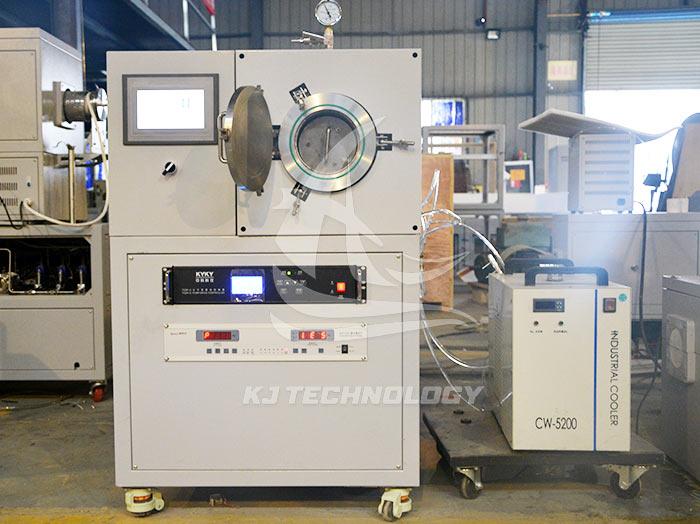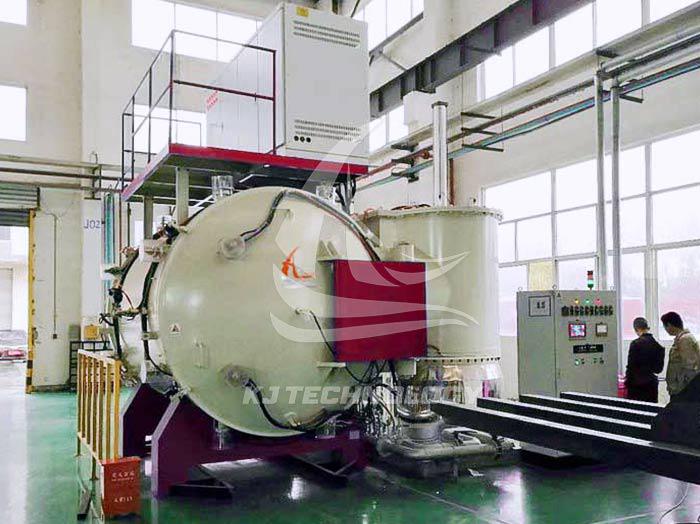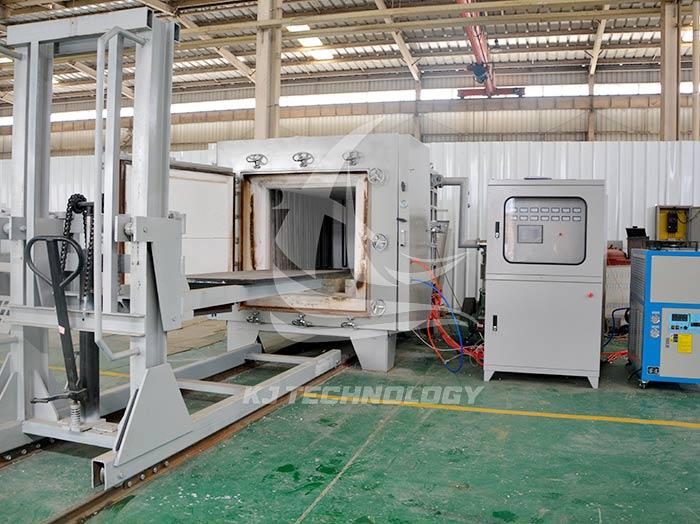Electric heating high-temperature vacuum heat treatment furnace
 06-06-2025 Author: KJ technology
06-06-2025 Author: KJ technology
Electric heating high-temperature vacuum heat treatment furnace is an advanced equipment that combines vacuum technology and heat treatment process.
1. Characteristics
Anaerobic environment treatment: Heat treatment is carried out in a vacuum state to avoid chemical reactions between the workpiece and oxygen, water vapor, etc. in the air, achieving no oxidation, decarburization, or carburizing, and maintaining the original performance of the workpiece.
High thermal efficiency: It can achieve rapid heating and cooling, improving heat treatment efficiency.
Surface Brightness Purification: It can remove phosphorus debris from the surface of the workpiece and has functions such as degreasing and degassing, making the surface of the workpiece brighter and cleaner.
Small deformation: The workpiece heats slowly in the furnace, with a small temperature difference, low thermal stress, and small deformation, which improves the product's qualification rate.
Improve mechanical performance and service life: It has a degassing effect, thereby enhancing the mechanical performance and service life of the product.
Preventing hydrogen embrittlement: The processed workpiece has no risk of hydrogen embrittlement, especially suitable for materials such as titanium and refractory metals that are prone to hydrogen embrittlement.
Good process stability and repeatability: conducive to ensuring consistency in product quality.
Widely applicable: can be used in multiple fields such as hard alloys, ceramics, stainless steel materials, powder metallurgy, metal injection molding, and vacuum sintering dewaxing.
2. Application scenarios
Heat treatment of metal parts: used for annealing, quenching, tempering and other heat treatment processes of metal parts.
Melting and casting of metal materials: Vacuum induction melting furnaces are used for precise melting and casting of metals and alloys, while vacuum melting furnaces are used for melting and casting metal materials in a vacuum environment to improve the purity and quality of metals.
Sintering of ceramic materials: Gas pressure sintering furnace and graphite vacuum furnace are high-tech equipment for sintering ceramic materials.
Surface treatment: such as vacuum coating furnace used to coat the surface of materials in a vacuum environment, improving the wear resistance and corrosion resistance of products; Electron beam high-temperature vacuum furnace is mainly used for surface treatment and thin film preparation of metal materials.
Welding: Vacuum welding furnaces are used to weld metal materials in a vacuum environment, improving welding quality and efficiency.
Powder metallurgy: Vacuum powder metallurgy furnaces are used to compress and sinter metal powders in a vacuum environment, producing high-quality metal products.
Drying: Vacuum drying furnace is used to remove moisture from substances and improve product quality.
3. Daily maintenance
Cleaning and maintenance
Exterior of the furnace: After daily use, wipe the exterior of the furnace with a clean cloth to remove dust, oil stains, and other impurities from the surface.
Sealing area of furnace door: It should be cleaned carefully to prevent impurities from affecting the sealing effect.
Observation window: Regularly clean the observation window on the furnace body to ensure clear observation of the situation inside the furnace. If there are stains on the observation window glass, a specialized glass cleaner can be used for cleaning.
Component inspection and replacement
Vacuum pump: Check the oil level of the vacuum pump to ensure that it is within the normal range. Generally, check the oil level once a week. According to the frequency of use, replace the vacuum pump oil every 3-6 months. When changing the oil, the old oil should be completely drained first, and then new oil should be added to the specified level. At the same time, during the oil change process, it is necessary to check the internal structure of the vacuum pump, such as the pump body, blades, etc., for wear or damage. Check the operation sound and temperature of the vacuum pump every day. Under normal circumstances, the operation sound of the vacuum pump is stable and the temperature is not too high (generally not exceeding 70-80 ° C). If abnormal sound or high temperature is found, stop the machine in time for inspection.
Heating element: Check the heating element every 3-6 months. For graphite heating elements, it is necessary to check for any signs of fracture, wear, or surface oxidation. If damage is found to the heating element, it should be replaced in a timely manner to avoid affecting the heating effect. Check if the connection parts of the heating element are secure. If loose connections are found, tighten the connection screws again to ensure a good electrical connection.
Internal inspection of furnace body: Conduct a comprehensive inspection of the furnace body every 6-12 months. Check whether the insulation material on the furnace wall is damaged or detached. If the insulation material is damaged, it should be repaired or replaced in a timely manner to ensure the insulation performance of the furnace body. Check whether the temperature measuring elements such as thermocouples and thermal resistors in the furnace are working properly. The accuracy can be determined by measuring their resistance values or comparing them with standard temperatures. If they are not accurate, they should be calibrated or replaced in a timely manner. Check whether the airflow distribution devices (such as deflectors, etc.) inside the furnace are deformed or damaged, to ensure that the airflow inside the furnace is uniform, and to ensure that the heat treatment effect is uniform and consistent.
Vacuum pipelines and valves: Regularly check the sealing of vacuum pipelines, and use a vacuum leak detector to inspect pipeline interfaces, valves, and other parts. Generally, a comprehensive vacuum leak test is conducted every 6-12 months. Maintain the vacuum valve, clean the dirt inside the valve, and check whether the sealing components of the valve are worn. If the seal is severely worn, it should be replaced to ensure the sealing and normal opening and closing function of the valve.
4. Safe operation
Operator requirements: Operators must undergo safety knowledge and professional training, and pass the assessment before they can operate on duty. The operator should ensure good physical condition during operation (no behavior that affects physical condition such as drinking alcohol), and should wear necessary labor protection equipment.
Workplace requirements: The high-temperature vacuum furnace workplace should be kept clean and ventilated; The safe passage should be kept unobstructed.
Equipment operation requirements
Preparation work: Check if all parts of the equipment are in normal condition; Check if the required water, power, and gas sources for the equipment are normal; Check whether various valves and control switches are in the closed state; Close the main power supply and check if all indicator lights are working properly.
Job requirements: Open the furnace door correctly and do not pry or press the furnace door locking device; During loading, ensure stability and avoid dropping workpieces or touching heating elements. Before closing the furnace door after loading, clean the sealing ring of the furnace door with a clean cloth (if insufficient compression or damage is found, the sealing ring should be replaced in a timely manner); Close the furnace door in the correct way and lock it with a locking ring. Do not pry or press the furnace door locking device. At the same time, confirm whether the locking device is closed in place (the locking device should always remain closed during equipment operation). If it is not closed in place, it needs to be repaired immediately; After the equipment is running normally, personnel should not approach or touch any moving or live devices on the equipment. If maintenance is required, the equipment should be stopped and the power should be turned off. Only when it is confirmed that there is no danger can manual maintenance be carried out; After the equipment is running, the operator should carefully and truthfully record the work (including data such as water pressure, current and voltage, air pressure, vacuum degree, and any abnormal situations that occur in the equipment); During the heating process of the equipment, the infrared thermometer should be calibrated in a timely manner to ensure the accuracy of temperature measurement; If any abnormalities are found during the heating and cooling process of the equipment, and it is necessary to stop evacuating, nitrogen should be filled for protection while stopping the vacuum system. Only when the conditions for opening the furnace door are met can the door be opened for inspection; If any abnormal situation is found during the operation of the equipment, it should be handled in the correct way and not operated arbitrarily.
Requirements for job completion: After the equipment is running, the furnace door should be opened for material retrieval according to the operating procedures; After completing the material retrieval work, it is necessary to clean the furnace thoroughly (if tools are required, it is recommended to use non-metallic tools); If the next furnace work is not carried out immediately, the furnace door should be closed to evacuate the equipment to a vacuum state and place it; Regularly observe the status of the cooling water and promptly handle any abnormalities found; If not used for a long time, a no-load operation should be conducted once a month; Before installing the sealing components during maintenance, it is necessary to check whether the sealing ring is damaged. If any damage is found, the sealing ring should be replaced in a timely manner to ensure the sealing effect.








